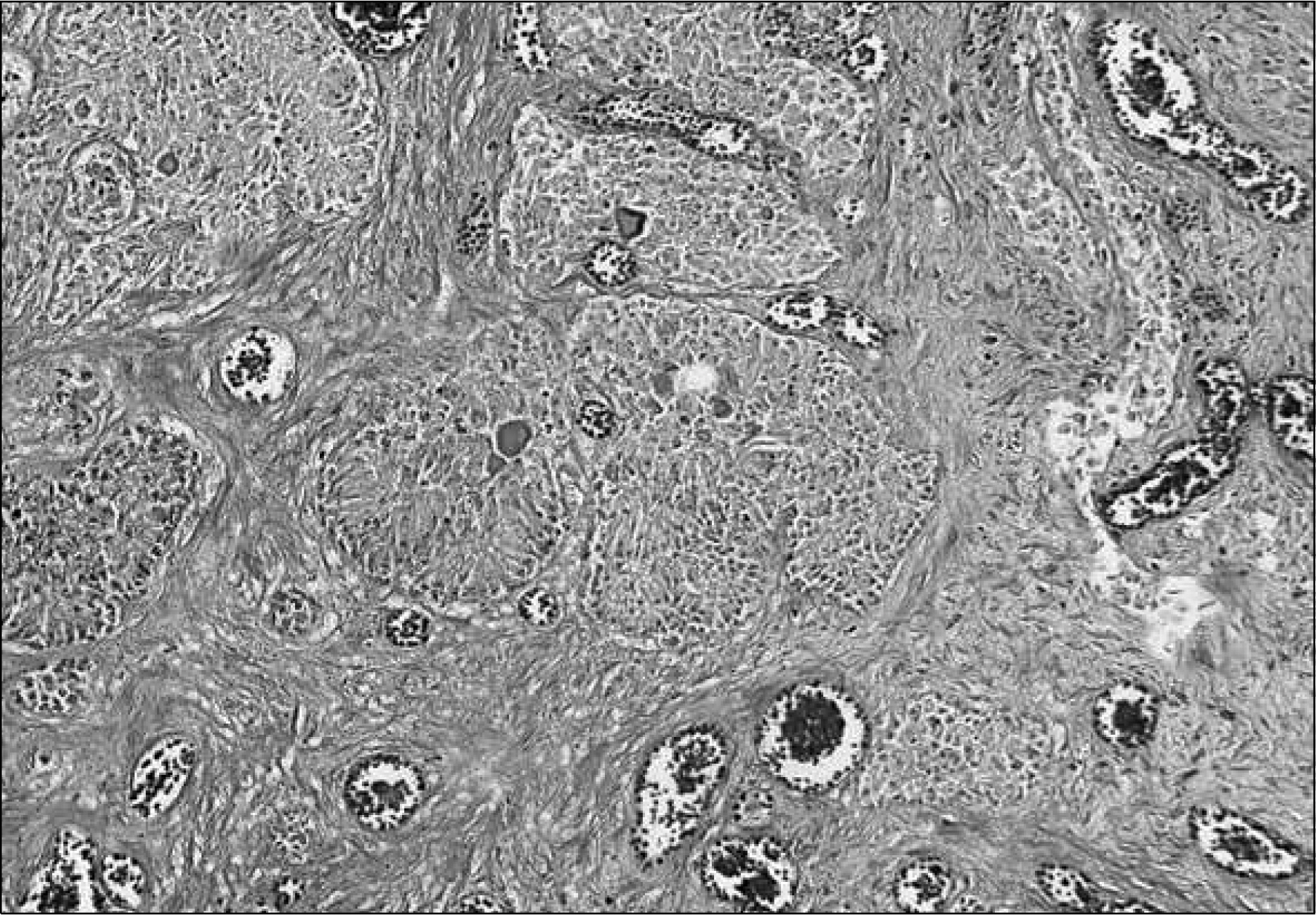Korean J Urol.
2008 Nov;49(11):997-1002. 10.4111/kju.2008.49.11.997.
The Effect of Chronic Prostatic Inflammation on Acute Urinary Retention in the Setting of Benign Prostatic Hyperplasia
- Affiliations
-
- 1Department of Urology, College of Medicine, Dongguk University, Gyeongju, Korea. ksleemd@dongguk.ac.kr
- 2Department of Pathology, College of Medicine, Dongguk University, Gyeongju, Korea.
- KMID: 1328171
- DOI: http://doi.org/10.4111/kju.2008.49.11.997
Abstract
-
PURPOSE: The aim of this study was to evaluate the effect of chronic prostatic inflammation on acute urinary retention(AUR) in the setting of benign prostatic hyperplasia(BPH).
MATERIALS AND METHODS
A total of 132 male patients admitted to our clinic with BPH-related AUR or BPH-related lower urinary tract symptoms (LUTS) were included in this study. These patients were divided into two groups. Group 1 consisted of 58 patients with AUR who underwent transurethral resection of the prostate(TURP), and group 2 consisted of 74 patients with LUTS who underwent TURP. Prostatic infarction, morphology, inflammation were examined. Prostatic infarction was evaluated according to the presence or absence of infarction. Prostatic morphology was assessed according to three categories: mainly glandular hyperplasia, stromal hyperplasia, or a mixture of glandular and stromal hyperplasia. Prostatic inflammation was assessed according to three categories: mild, moderate, and severe.
RESULTS
Prostatic infarction was observed in 8.6% of the patients in group 1 and in 8.1% of the patients in group 2(p=1.000). Glandular, stromal, and mixed hyperplasia were detected in 36.2%, 5.2%, and 58.6% of the patients in group 1 and in 35.1%, 6.8%, and 58.1% of the patients in group 2, respectively(p=0.222). Mild, moderate, and severe chronic prostatic inflammation were observed in 39.7%, 31.0%, and 29.3% of the patients in group 1 and in 73.0%, 20.3%, and 6.7% of the patients in group 2, respectively(p<0.001). CONCLULSIONS: Chronic prostatic inflammation may play an important role on AUR developing secondary to BPH.
Keyword
Figure
Reference
-
References
1. Murray K, Massey A, Feneley RC. Acute urinary retention-a urodynamic assessment. Br J Urol. 1984; 56:468–73.2. Klarskov P, Andersen JT, Asmussen CF, Brenoe J, Jensen SK, Jensen IL, et al. Symptoms and signs predictive of the voiding pattern after acute urinary retention in men. Scand J Urol Nephrol. 1987; 21:23–8.
Article3. Jacobsen SJ, Jacobson DJ, Girman CJ, Roberts RO, Rhodes T, Guess HA, et al. Natural history of prostatism: risk factors for acute urinary retention. J Urol. 1997; 158:481–7.
Article4. Kirby R, Lepor H. Evaluation and nonsurgical management of benign prostatic hyperplasia. Wein AJ, Kavoussi LR, Novick AC, Patrin AQ, Peters CA, editors. editors.Campbell's urology. 9th ed.Philadelphia: Saunders;2007. p. 2774–5.5. Choong S, Emberton M. Acute urinary retention. BJU Int. 2000; 85:186–201.
Article6. Shapiro E, Hartanto V, Lepor H. The response to alpha blockade in benign prostatic hyperplasia is related to the percent area density of prostate smooth muscle. Prostate. 1992; 21:297–307.
Article7. Shapiro A, Mazouz B, Caine M. The alpha-adrenergic blocking effect of prazosin on the human prostate. Urol Res. 1981; 9:17–20.
Article8. Caine M, Perlberg S. Dynamics of acute retention in prostatic patient and the role of adrenergic receptors. Urology. 1977; 9:399–403.9. Spiro LH, Labay G, Orkin LA. Prostatic infarction. Role in acute urinary retention. Urology. 1974; 3:345–7.10. Jones TJ, Howie AJ. Necropsy study of infarcts of prostate and prostatic urethra. J Clin Pathol. 1986; 39:1221–3.
Article11. Baird HH, Mckay HW, Kimmelstiel P. Ischemic infarction of the prostate gland. South Med J. 1950; 43:234–40.
Article12. Anjum I, Ahmed M, Azzopardi A, Mufti GR. Prostatic infarction/infection in acute urinary retention secondary to benign prostatic hyperplasia. J Urol. 1998; 160:792–3.
Article13. Tuncel A, Uzun B, Eruyar T, Karabulut E, Seckin S, Atan A. Do prostatic infarction, prostatic inflammation and prostate morphology play a role in acute urinary retention? Eur Urol. 2005; 48:277–84.
Article14. Griffiths K, Cockett AT, Coffey D, Krieg M, Lee C, Mc-Keehan W, et al. Regulation of prostatic growth. Denis L, Griffiths K, Khoury S, Cockett AT, McConnell J, Chatelain C, editors. editors.4th International Consultation on Benign Prostate Hyperplasia. Plymouth: WHO;1997. p. 85–128.15. Abeshouse BS. Infarct of the prostate. J Urol. 1933; 30:97–112.
Article16. Atan A, Horn T, Hansen F, Jakobsen H, Hald T. Benign prostatic hyperplasia. Does a correlation exist between prostatic morphology and irritative symptoms? Scand J Urol Nephrol. 1996; 30:303–6.
Article17. Nadler RB, Humphrey PA, Smith DS, Catalona WJ, Ratliff TL. Effect of inflammation and benign prostatic hyperplasia on elevated serum prostate specific antigen levels. J Urol. 1995; 154:407–13.
Article18. Kefi A, Koseoglu H, Celebi I, Yorukoglu K, Esen A. Relation between acute urinary retention, chronic prostatic inflammation and accompanying elevated prostate-specific antigen. Scand J Urol Nephrol. 2006; 40:155–60.
Article19. Nickel JC, Downey J, Young I, Boag S. Asymptomatic inflammation and/or infection in benign prostatic hyperplasia. BJU Int. 1999; 84:976–81.
Article20. Scattoni V, Raber M, Montorsi F, Da Pozzo L, Brausi M, Calori G, et al. Percent of free serum prostate-specific antigen and histological findings in patients undergoing open prostatectomy for benign prostatic hyperplasia. Eur Urol. 1999; 36:621–30.
Article
- Full Text Links
- Actions
-
Cited
- CITED
-
- Close
- Share
- Similar articles
-
- The recovery of the destusor muscle function in acute urinary retention patients due to benign prostatic hyperplasia
- Relationship between Acute Urinary Retention and Intraprostatic Inflammation in Benign Prostatic Hyperplasia
- Clinical characteristics of the associated histopathological findings in benign prostatic hyperplasia
- The effect of prazosin as a first-line therapy for the symptomatic benign prostatichypertrophy
- Post Prostatectomy Prognostic Factors in Patients with Acute Urinary Retention due to Benign Prostatic Hyperplasia




